Puzzles, Persistence and Play!
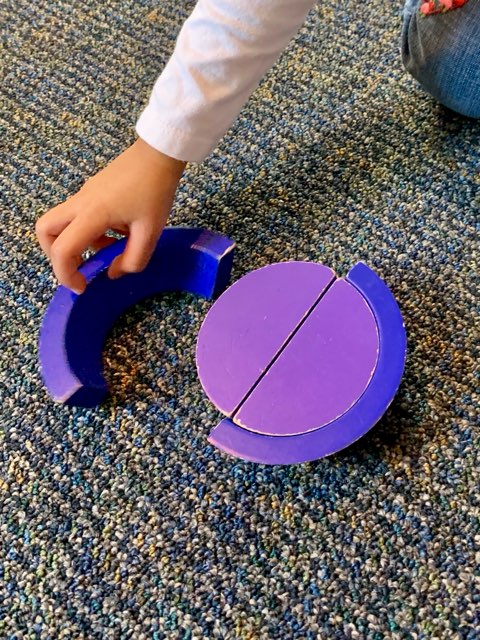
Out of the corner of my eye, I notice three-year-old Saaliha, who is patiently working her way through a rainbow puzzle. Her friends are busy in other parts of the classroom, but Saaliha is problem-solving her way to puzzle mastery. I sit down next to her to observe her learning style, and she is so engrossed in her learning that my presence goes unnoticed.

Open-ended materials such as Saaliha’s rainbow puzzle often lead to long periods of deep concentration and learning. Today is no different. Although this rainbow puzzle often lands in the block area in the shape of a snake, a tunnel or a flowing river, Saaliha is trying to assemble the pieces so that the puzzle will fit back into its round wooden tray for storage.
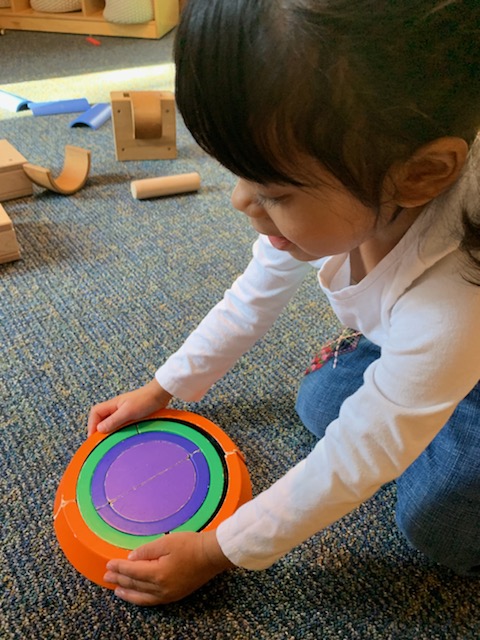
Puzzle play is a great time to build cognitive and fine-motor skills. In addition to finding the correct sequence of sizes, Saaliha must determine how each block must be placed to complete the puzzle. I watch as Saaliha flips, turns and rotates the pieces to figure out where they go and in what order.
I love observing Saaliha’s learning style and seeing how it corresponds to her developmental level. I see her set aside pieces that are not needed at the moment. Saaliha’s spatial awareness is growing with each try.
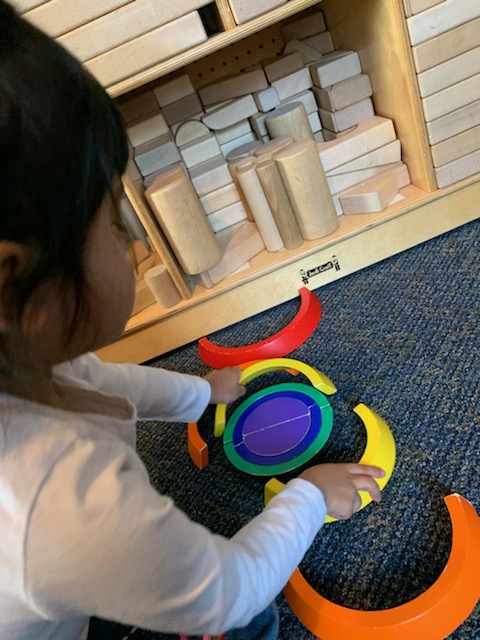
As Saaliha plays with the puzzle, I note how her choices and strategies change. She begins to recognize and understand how the pieces fit together to complete the puzzle. I watch her sorting and testing pieces of different sizes and moving them in different directions until each piece fits properly.
As she builds her spatial awareness, Saaliha is also strengthening the small muscles in her hands while improving her manual dexterity and building foundational problem-solving and critical-thinking skills. This is a learning adventure that requires the eyes, hands and brain to work together!

Saaliha is soon joined by her two-year-old buddy, Eleanor. These two best friends are 11 months apart in age—with different learning styles and different levels of brain development.
As they work together to fit the yellow arch into the puzzle, they discuss and test out different strategies. The collaboration continues as Eleanor tries to solve a problem her older friend could not.
Saaliha never reaches over to remove the piece from her younger friend’s hand. She is observing and reasoning as deeply as she had been moments earlier when the puzzle piece was in her own hand. Eleanor quickly loses interest, but Saaliha perseveres.

Saaliha tries new pieces and new directions. I can practically see the wheels turning in her brain. She is coming up with new ideas and testing out different theories.
She is not rushed or agitated, and she doesn’t ask for assistance. She simply keeps trying new patterns and new pieces. In short, she is riveted to this learning opportunity.
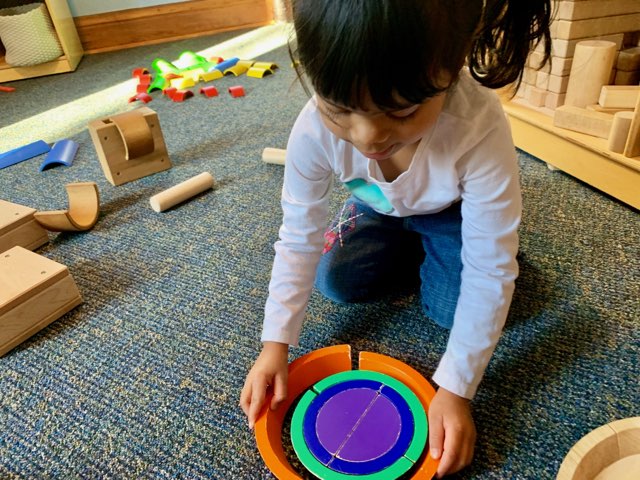
Suddenly it all clicks into place. Saaliha has an “Aha” moment, and I can see her confidence surge as she fits the pieces together more quickly. She has solved the puzzle!
There is no celebration, just a smile of satisfaction. She studies the finished project. Before I can capture her expression of satisfaction with my camera, she disassembles the puzzle to do it over again.
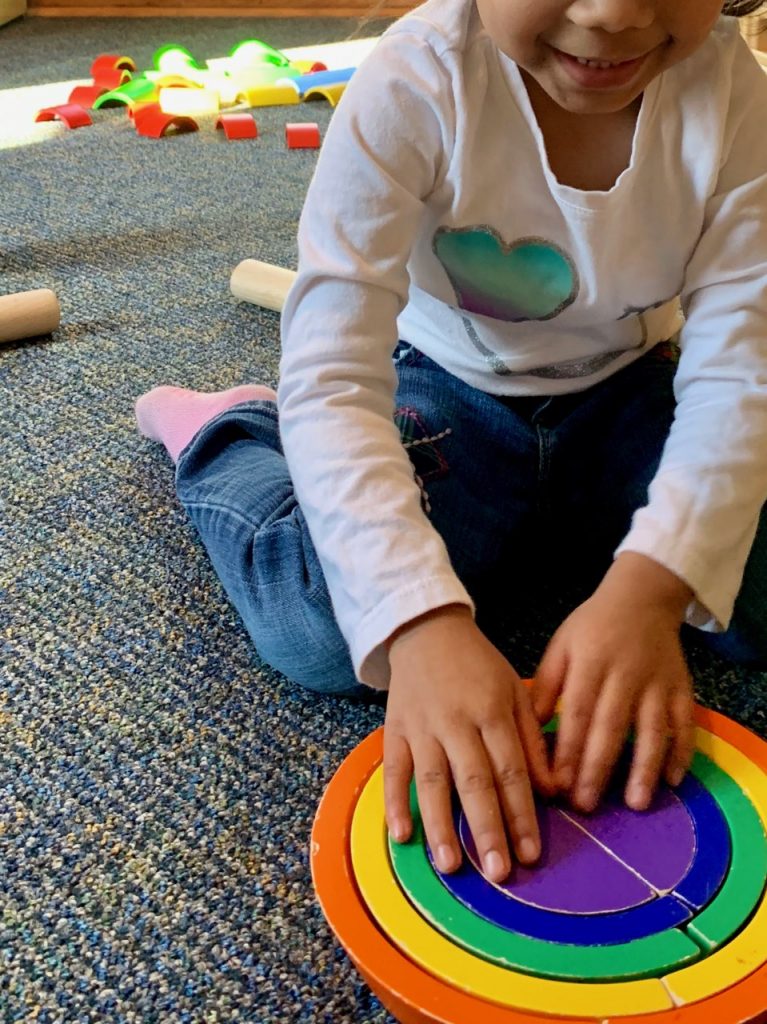
As Saaliha starts over, I continue to observe her strategies and methods. Her perseverance continues to reward her with stronger puzzle-solving skills.
What better way to build an early math foundation?
an extension would be to make this using plates
Puzzles are great for math
This was a nice read! I love how children think and how curious they are about learning new things and the choices they make at ages and stages.
I love to challenge my kids’ using games. We change the rules and they become our classroom rules. But to watch a child use many different skills that solve a puzzle on their own, without asking for help is amazing. I usually use it as a memorable moment in class and take notes on how they did.
Thank you.
Wonderful Moment of Playful Learning …
love how children use this puzzles for different things as well as for tunnels for cars.
Watching the three-year-old dive into solving puzzles with focus and determination brings back my childhood memories. It’s amazing how infusing play into these challenges sparks joy and curiosity. Seeing Saaliha team up with her two-year-old friend, Eleanor, adds a sweet social aspect, highlighting the beauty of exploring and working together. That moment of realization, the “Aha” moment, and the satisfaction Saaliha gets from it transport me back to the pure joy of discovering new things. It’s a reminder that learning isn’t just about reaching a goal; it’s about finding delight in the journey itself.
I enjoyed reading this article because you related a specific developmental skill as Sahila manipulated the pieces of the puzzle.
Great reading materials. Good ideas.
I think this is nice because it shows children that it is a growing pattern by adding a color on until the puzzle is complete
puzzles are a great way for children to learn math and problem solve. i love materials that support multiple areas of learning.
We have this manipulative at my center and the kids love playing with it. However, they never really use it like it should be used but it is entertaining to watch them do their own thing with it.
I love this! My daycare kids love puzzles and building things. They are always so hapoy with themselves when they master the task.
Just now introducing my infants to puzzles. So far so good. We use the puzzles with the knob on them so the infants can pick the pieces up.
Puzzles are great. We just introduced them to the infants.
Loved Saaliha’s persistence. This is a good example for a teacher to hush and let the magic of a little one’s determination and joy of learning its thing.
This is a great way to expand a student’s mind and the will also start building muscle memory on how shapes truly are
The idea is means for children to problem solve on their own.
Interesting.
This was an interesting example of seeing how children are able to problem solve on their own without any help. And shows how interesting math can be to young children.
The children love puzzles so we give them many options